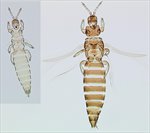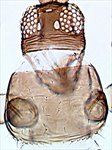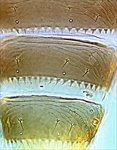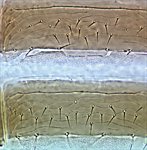
abdominalis male & female

abdominalis head & pronotum

abdominalis prosternites

abdominalis tergites VI-VIII

abdominalis sternites IV-V

abdominalis male sternites

abdominalis fore wing
Generic diagnosis
Female macropterous. Head clearly smaller than pronotum; maxillary palps 3-segmented; eyes large, without pigmented facets; ocellar setae I absent; setae III not elongate; five pairs of postocular setae. Antennae 7-segmented, segment I without paired dorso-apical setae, III and IV with sense-cones forked, III–VI with some rows microtrichia on both surfaces. Pronotum wider than long, with two pairs of rather small posteroangular setae; four to seven pairs of posteromarginal setae. Mesonotum with median pair of setae far from posterior margin; anteromarginal campaniform sensilla present. Metanotum with closely spaced longitudinal striae; median pair of setae situated far from anterior margin, campaniform sensilla present. Fore wing first vein with long gap in setal row; clavus usually with five veinal and one discal setae; posteromarginal fringe cilia wavy. Prosternal ferna divided medially; basantra membranous, with several small setae. Mesosternum with sternopleural sutures complete; endofurca with spinula; spinasternum broad and transverse. Metasternal endofurca without spinula. Tarsi 2-segmented. Tergites I–VII with craspeda of large tooth-like lobes; V–VIII with paired ctenidia, on VIII posteromesad to spiracle; VIII with marginal comb complete, microtrichia arising from large tooth-like bases; IX with two pairs of campaniform sensilla, MD setae present; X with complete longitudinal split. Sternites with discal setae, without craspeda; III–VII with three pairs of posteromarginal setae, II with two pairs; VII with median setae in front of margin, laterotergites without discal setae.
Male macropterous, similar to female; antennal segments III and IV with sense-cones simple or forked; sternites II–VII with craspeda bearing large tooth-like lobes; III –VII each with a pore plate.
Biological data
Commonly breeding in the flowers of Helianthus, including crops of sunflowers, as well as the flowers of the widespread weed, Ageratum conyzoides, and many other Asteraceae.
Distribution data
Widespread around the world in tropical countries (Mound et al., 2017).
Nomenclatural data
Microcephalothrips Bagnall, 1926: 113. Type species Thrips abdominalis Crawford 1910, by monotypy.
Only one species is placed in this genus (ThripsWiki, 2020), and this introduced species is widespread in China:
abdominalis (Crawford DL, 1910: 157). (Thrips)
Relationship data
Thripidae sub-family Thripinae: this is a diverse group involving more than 230 genera. The single species placed in Microcephalothrips is distinguished from Thrips genus by the distinctive autapomorphy of the presence of a group of setae medially on the prosternum. It is one of a very few genera of Thripinae in which species have such a group of setae.
References
Mound LA, Nielsen M & Hastings A (2017) Thysanoptera Aotearoa - Thrips of New Zealand. Lucidcentral.org, Identic Pty Ltd, Queensland, Australia. http://keys.lucidcentral.org/keys/v3/nz_thrips/
ThripsWiki (2020). ThripsWiki - providing information on the World's thrips. <http://thrips.info/wiki/Main_Page>
zur Strassen R (2003) Die terebranten Thysanopteren Europas und des Mittelmeer-Gebietes. Die Tierwelt Deutschlands 74: 1–271.